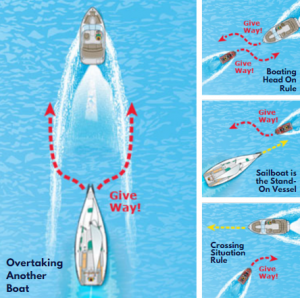Expert Tips for Navigating Recreational Boats in Canada’s Busiest Harbours
Navigating the busiest harbours in Canada requires knowledge, preparation, and adherence to safety protocols. On June 9, 2024, a video posted online shows a Harbour Air seaplane on liftoff from Coal Harbour, BC crashing across the top of a recreational boat. Transport Canada flew in a team to investigate the incident. Although, there were injuries, no one died. However, the float plane sank. This is not the first major accident in one of Canada’s busy harbours this boating season. The Transportation Safety Board of Canada (TSB) also deployed a team of investigators to investigate a collision between the passenger vessel Navark Faucon Millenium and a pleasure craft, that occurred in June near Longueuil, Quebec. Navigating busy Canadian harbours can be tricky, especially in places like Coal Harbour that have cruise ships, tankers, sea buses, float planes and other marine traffic coming and going.
Canada’s busiest harbours
-
- Port of Vancouver: The largest port in Canada and the busiest on the Pacific coast, handling a significant amount of commercial traffic alongside recreational activities. The Port of Vancouver is a great resource for boat safety.
- Port of Montreal: A major inland port on the St. Lawrence River, crucial for both commercial shipping and recreational boating.
- Port of Toronto: Located on Lake Ontario’s northwest shore, is a major inland port and crucial to the city’s economy, linking Toronto to the St. Lawrence Seaway and global marine ports. Primarily handling bulk cargo, it also offers intermodal links to road, rail, and air transport, and hosts cruise ships.
- Port of Halifax: An essential Atlantic gateway, busy with commercial and recreational traffic.
- Port of Quebec: Located on the St. Lawrence River, known for its strategic location and heavy traffic from various vessel types. Follow the practices and procedures related to navigation.
Understand and follow collision regulations
 The Collision Regulations (ColRegs) under the Canada Shipping Act 2001 are like traffic laws for boats, promoting safe navigation in all waters. These rules ensure predictable behaviour, reducing the risk of collisions. Mariners rely on each other to follow ColRegs, leading to fewer accidents and more efficient shipping. Most fatal marine accidents happen on commercial vessels, particularly in the fishing industry. For recreational boaters, understanding and following these regulations is crucial for safety.
The Collision Regulations (ColRegs) under the Canada Shipping Act 2001 are like traffic laws for boats, promoting safe navigation in all waters. These rules ensure predictable behaviour, reducing the risk of collisions. Mariners rely on each other to follow ColRegs, leading to fewer accidents and more efficient shipping. Most fatal marine accidents happen on commercial vessels, particularly in the fishing industry. For recreational boaters, understanding and following these regulations is crucial for safety.
Tips navigating busy Canadian harbours
Stay up to date: Monitor weather conditions and marine traffic updates. Use apps or VHF radio to stay informed about the latest conditions and notices to mariners.
Use navigation tools: Equip your boat with up-to-date charts, GPS, and radar if possible. Know the layout of the harbour, including all navigation aids and traffic separation schemes.
Follow traffic patterns: Adhere to established traffic lanes and separation schemes. Larger vessels have limited maneuverability and visibility, so stay clear of their paths.
Communicate: Maintain constant communication with harbour authorities and other vessels. Monitor VHF channels 16 and 12 for updates and communicate your intentions clearly. The Canadian Coast Guard offers valuable resources for safe navigation through its Marine Communications and Traffic Services (MCTS). They provide real-time updates on marine traffic, weather conditions, and navigational hazards.
Exercise caution: Keep a safe distance from larger vessels, tugboats, and their tows. Large ships have significant blind spots and cannot stop or turn quickly.
Plan ahead: Know the entry and exit points of the harbour. Plan your route carefully and be aware of any restricted areas or construction zones.
Be visible and audible: Ensure your vessel is visible and use sound signals appropriately. If navigating near floatplanes, be aware of their landing and takeoff zones and give them plenty of space.
Anchor wisely: Use designated anchorages and follow local anchoring rules to avoid obstructing traffic or causing environmental harm.
Report incidents: Know how to report any incidents or emergencies. Have the contact details of the local port operations centre and emergency services handy.
Choose a less busy harbour: If possible, try to navigate your route and stopovers using a smaller, less busy harbour. The Government of Canada, under Fisheries and Oceans, has an abundance of information on the small craft harbours resource page.
By following these guidelines, being informed and communicating with harbour masters, recreational boaters can safely navigate busy Canadian harbours and enjoy their time on the water.
Resources for navigating busy Canadian harbours
Port of Toronto: Harbour Master Notices for boaters
League Law: Marine accidents in Canada
Global News: Coal Harbour plane crash
Transportation Safety Board: Near miss and overturned pleasure craft
Transportation Safety Board: Investigations
CTV News: 2 injured after boat collides with ferry north of Quebec City
Safe Harbour Insurance: Boat Navigation: Rules of the Road